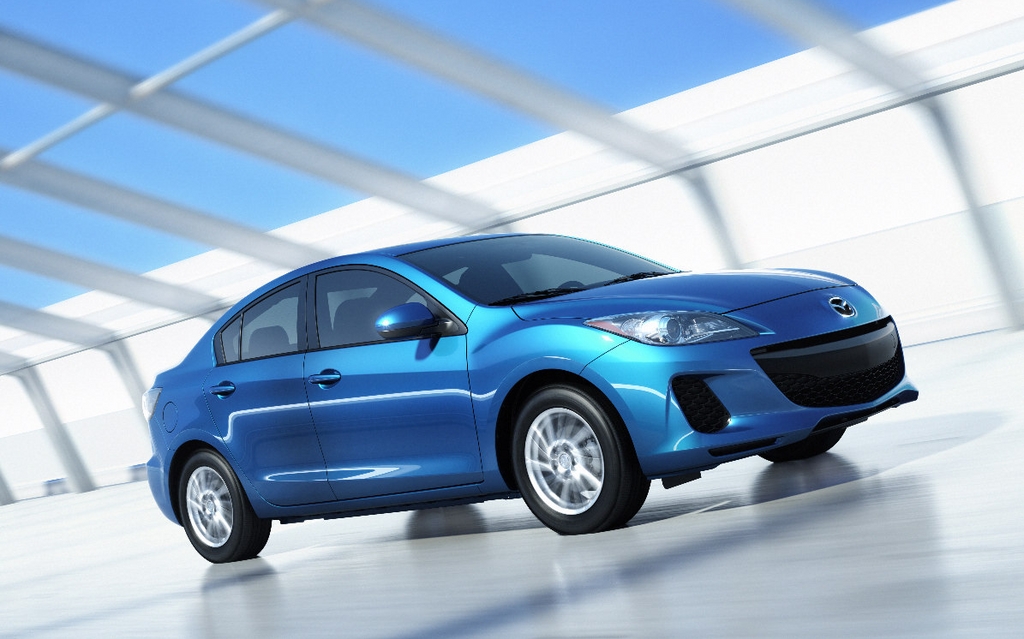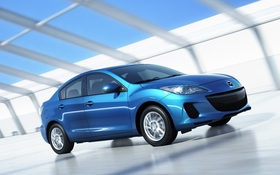2012 Mazda3 SKYACTIV: Now with improved fuel consumption and driving pleasure

| Strong points |
|
|---|---|
| Weak points |
|
More than a year has passed since Mazda unveiled its SKYACTIV technology, which is designed to cut fuel consumption in both gas and diesel engines. Anyone who follows the automotive news has heard that Mazda has developed various technologies for engines, transmissions and platforms to ultimately improve vehicle performance while making them more pleasant to drive and fuel efficient. When this technology launched in September 2010, Mazda promised that fuel economy would range from 12-15%.
Several media events have been held since then, and I recently had the chance to drive a SKYACTIV version of the new CX-5 that will hit dealerships in the first quarter of 2012. Mazda also decided to release a SKYACTIV version of the Mazda3 on our market, given that it is Mazda’s best-selling model in the Americas, accounting for 50% of their sales in Canada. But there’s a caveat. It doesn’t come with the whole gamut of SKYACTIV technology. So, what are we missing out on?
A fair trade-off
As I mentioned earlier, this new technology is applied to the motors, powertrains and platform. In the case of the Mazda3, however, the new platform won’t be released for another couple of years. This means that potential buyers who want to get in on the benefits of SKYACTIV technology will have to opt for a SKYACTIV version minus the snazzy platform. You just get the new engine and transmission. Meanwhile, on the mechanical front, the only component that isn’t being offered right now is the 4-2-1 exhaust manifold (gas passes through four collectors, then two, then one). This was left out because there isn’t enough room under the hood. Instead, the Mazda3 comes with the same 4-1 exhaust manifold used on other vehicles with four-cylinder engines (gas goes immediately into a single exhaust).
The result is a product that is interesting, slightly modified (due to Mazda’s usual three-year overhaul) and offers updated mechanics.
The new SKYACTIV 2.0-litre engine is simple yet clever. The engineers didn’t bother with complex mechanical components, unusual materials or onerous manufacturing methods. In essence, they focussed on reducing friction, making the moving parts inside the engine lighter and optimizing the combustion process. It now features increased piston stroke length, reduced cylinder bore diameter, and a 12:1 compression rate in the gas engine. A special cavity on the upper portion of the piston as well as multi-hole injectors improves combustion, which is enough on its own to reduce fuel consumption.
The manual gearbox, which is based on the MX-5 manual gearbox, has slimmed down, while several of its components were revised to reduce friction. Plus, the engineers developed a six-speed automatic transmission featuring internal mechanics that effectively combine the advantages of a continuously variable transmission and a double-clutch. Instead of offering an all-new platform like the one available on the CX-5, this car was tweaked to reduce vibrations.
In a nutshell, this compromise makes a lot of sense. In my opinion, this was a much smarter idea than making us wait for two more years for the benefits of SKYACTIV.
Parsimonious changes
Aside from the new SKYACTIV system, the Mazda3 was due for some updates. Mazda makes a point of reviewing its vehicles at mid-cycle. Since this car already offered great balance, they decided to keep these changes to a minimum. For the car’s exterior, they modified the front grille and its controversial smile. The bar that runs across it is now bigger, balancing its appearance. The rear bumper has been lowered and the new alloy wheels have been restyled. Inside, we find superior quality cloth on the seats and the information centre screen on the upper part of the dash is now easier to read thanks to white lettering. The indicator dial lighting varies depending on the trim level. Regular versions come with grey backlighting, SKYACTIV models come with blue lighting, and the Mazdaspeed3 features red. Meanwhile, the dashboard is very unique and makes the car look a lot more expensive than it is.
It would be too long and complicated to describe each trim, but suffice it to say that there’s a base GX with a regular 2.0-litre engine and a SKYACITV GS with an engine with the same name. Although they both feature the same engine displacement, the regular motor produces 148 horsepower whereas the 2.0-litre SKYACTIV delivers 155 horsepower. Note that these two engines are completely different from one another. Finally the GT models are the most expensive – and best equipped – of the bunch. They’re powered by a 1.5-litre 167-hp engine. Naturally, the Mazdaspeed3 is also available with its 263 horses.
More than just fuel economy
When Mazda invited journalists to California to test out its new technology, their objective was to convince us of the virtues of these mechanics and how they work to cut down on fuel consumption. So, here’s the beef: It works. On the highway, we recorded an average of 5.0 L/100 km, while the average rate was approximately 7.0 L/km. In either case, it boils down to about 15% less. Not bad!
Now, no one can say that this Mazda is thirstier than average. In fact, this car figures among the most fuel efficient in its category. But that’s just part of the equation.
The added bonus is that this vehicle also offers far superior driveability compared to the average, and its road handling is very impressive. Our test circuit took us through the California back-country mountains, and it handled corner after corner with finesse. My road companion and I didn’t hold back on speed, and even still the car handled superbly, without a peep from the tires on corners.
Admittedly, the 2.0-litre engine doesn’t offer mind-blowing accelerations, but the performance we got out of the super-efficient transmission was a lot of fun. In fact, we had such a good time with this car that we forgot to take pictures! That’s why the pics shown here are those provided by Mazda. Yeah, that was a good day…
In sum, this automaker has come through on its promise of cutting fuel consumption. Not only that, but after testing this car, we can safely say that it offers exceptional balance both in terms of road handling and driving pleasure. Before this trial, I had actually driven a regular Mazda3 with a conventional 2.0-litre engine and found its fuel consumption a bit high. Other than that, though, it was just as fun to drive.
Whatever model you choose, the improved 2012 Mazda3 is a great choice for anyone who loves driving.











